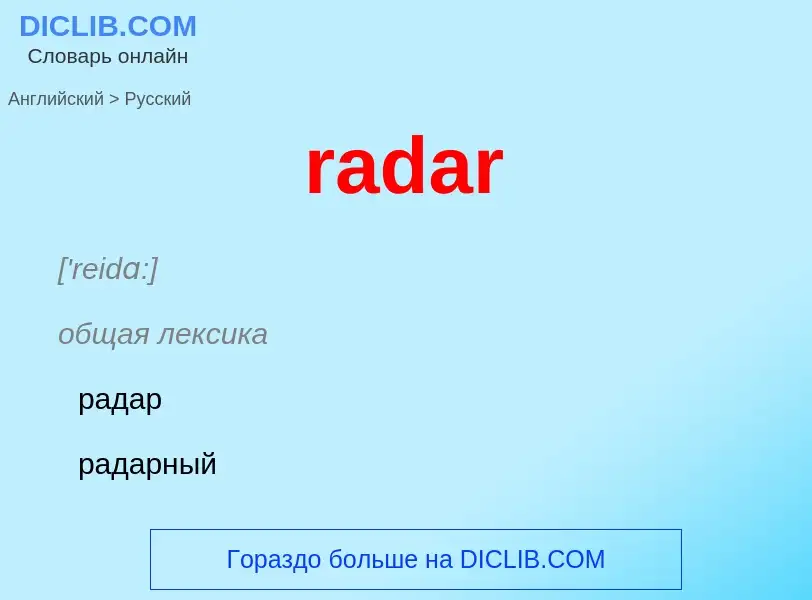Перевод и анализ слов искусственным интеллектом ChatGPT
На этой странице Вы можете получить подробный анализ слова или словосочетания, произведенный с помощью лучшей на сегодняшний день технологии искусственного интеллекта:
- как употребляется слово
- частота употребления
- используется оно чаще в устной или письменной речи
- варианты перевода слова
- примеры употребления (несколько фраз с переводом)
- этимология
RADAR - перевод на русский
['reidɑ:]
общая лексика
радар
радарный
радиолокатор
радиолокационный
радионавигационный
техника
радиолокация
радиофизический
станция радиолокационная
прилагательное
общая лексика
радиолокационный
радарный
существительное
['reidɑ:]
общая лексика
радиолокатор
радар
радиолокация
радиолокационная станция (РЛС)
радиолокатор, радар
радиолокационная установка
радиолокаци
общая лексика
облучение радиолокатором
существительное
общая лексика
радиолокационная станци
синоним
Определение
Википедия

Radar is a radiolocation system that uses radio waves to determine the distance (ranging), angle (azimuth), and radial velocity of objects relative to the site. It is used to detect and track aircraft, ships, spacecraft, guided missiles, and motor vehicles, and map weather formations, and terrain. A radar system consists of a transmitter producing electromagnetic waves in the radio or microwaves domain, a transmitting antenna, a receiving antenna (often the same antenna is used for transmitting and receiving) and a receiver and processor to determine properties of the objects. Radio waves (pulsed or continuous) from the transmitter reflect off the objects and return to the receiver, giving information about the objects' locations and speeds.
Radar was developed secretly for military use by several countries in the period before and during World War II. A key development was the cavity magnetron in the United Kingdom, which allowed the creation of relatively small systems with sub-meter resolution. The term RADAR was coined in 1940 by the United States Navy as an acronym for radio detection and ranging. The term radar has since entered English and other languages as a common noun, losing all capitalization.
The modern uses of radar are highly diverse, including air and terrestrial traffic control, radar astronomy, air-defense systems, anti-missile systems, marine radars to locate landmarks and other ships, aircraft anti-collision systems, ocean surveillance systems, outer space surveillance and rendezvous systems, meteorological precipitation monitoring, altimetry and flight control systems, guided missile target locating systems, self-driving cars, and ground-penetrating radar for geological observations. Modern high tech radar systems use digital signal processing and machine learning and are capable of extracting useful information from very high noise levels.
Other systems similar to radar make use of other parts of the electromagnetic spectrum. One example is lidar, which uses predominantly infrared light from lasers rather than radio waves. With the emergence of driver-less vehicles, radar is expected to assist the automated platform to monitor its environment, thus preventing unwanted incidents.


![3D Doppler radar spectrum showing a [[Barker code]] of 13 3D Doppler radar spectrum showing a [[Barker code]] of 13](https://commons.wikimedia.org/wiki/Special:FilePath/3D Doppler Radar Spectrum showing a Barker Code of 13.jpg?width=200)
![A [[Chain Home]] tower in Great Baddow, Essex, United Kingdom A [[Chain Home]] tower in Great Baddow, Essex, United Kingdom](https://commons.wikimedia.org/wiki/Special:FilePath/Chain home.jpg?width=200)
![Experimental radar antenna, US [[Naval Research Laboratory]], Anacostia, D. C., from the late 1930s (photo taken in 1945) Experimental radar antenna, US [[Naval Research Laboratory]], Anacostia, D. C., from the late 1930s (photo taken in 1945)](https://commons.wikimedia.org/wiki/Special:FilePath/Early radar antenna - US Naval Research Laboratory Anacostia.jpg?width=200)

![[[Phased array]]: Not all radar antennas must rotate to scan the sky. [[Phased array]]: Not all radar antennas must rotate to scan the sky.](https://commons.wikimedia.org/wiki/Special:FilePath/PAVE PAWS Radar Clear AFS Alaska.jpg?width=200)





![The first workable unit built by [[Robert Watson-Watt]] and his team The first workable unit built by [[Robert Watson-Watt]] and his team](https://commons.wikimedia.org/wiki/Special:FilePath/Watson Radar.jpg?width=200)
![Memorial plaque commemorating Robert Watson-Watt and [[Arnold Wilkins]] Memorial plaque commemorating Robert Watson-Watt and [[Arnold Wilkins]]](https://commons.wikimedia.org/wiki/Special:FilePath/Watson watt 02 fr.jpg?width=200)
